The Need For Measurement
The ever-elusive white whale of corporate training programs is measuring Return on Investment (ROI). A precise and reliable mathematical formula to demonstrate ROI would solve so many problems. Learning development teams could defend their important role to people in the C-suite. C-level leadership would know exactly what they are buying with their resources and be able to accurately predict outcomes. Precision reporting to corporate boards would be more in line with capital expenditures and other more historically measurable investments of limited resources. Learning teams would be able to communicate to learners how learning will make their company stronger and healthier. Pie charts and spreadsheets would provide data support for qualitative stories about people who were able to increase productivity and advance to higher job levels.
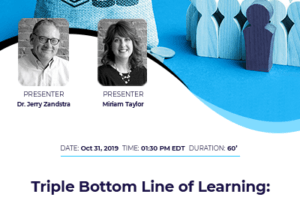
Globally, companies spend over $175 billion per year on training. This includes in-house training, job shadowing, tuition reimbursement, classroom training, digital learning, per diems, hotels, food, Instructional Designers, artists and a host of other expenditures. It involves hundreds of millions of people and billions of hours, which is a significant amount of money, time and effort.
There is some debate about who first said, “If you think education is expensive, try ignorance.” Some attribute the quote to Derek Bok, former president of Harvard University. Others claim that advice columnist Ann Landers first used the expression. Regardless of the source, the sentiment expressed is undoubtedly true, but it does not resolve the dilemma.
That is why metrics matter. Measurement, precision and predictability matter. The investment is simply too large to be left to platitudes. Productivity growth and competition will not allow companies to continue to invest heavily in training and learning without a comprehensive system that can speak accurately and completely about their potential return.
The training industry is keenly aware of this need. So are many people in the C-suite. But a traditional conception of ROI will not give us the answer or the insight we all seek.
Failure Of Traditional ROI
Let’s begin with the math. Calculating ROI for learning is relatively simple. The formula is simple:
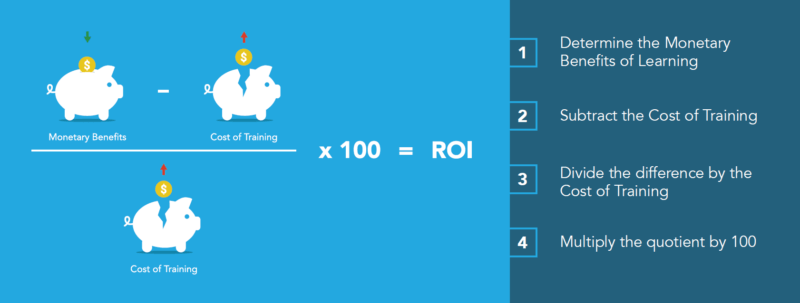
For example, let’s say the monetary benefit of training is $250,000 and the cost of training is $100,000. Our formula would be:

However, where training is concerned, looking at traditional ROI calculations does not provide a complete picture. People who lead Learning and Development programs for their companies understand this and are looking for a better way to justify the cost of training to those who create budgets and set goals. Attend any conference focused on corporate learning and you will find that any session about clarifying ROI for learning will be standing room only. Everyone is looking for the formula that will empower them to return to their company, make a clear and compelling case to management for their existing budget (and likely for an increase in the budget), and be a hero among their peers.
Maybe this makes CFOs smile, but most people who have spent some time leading training departments well know that the matter is not so simple. Learning programs require much more than just a financial investment.
The troubling truth is that traditional ROI is a flawed method for measuring the impact of learning on a corporation. No matter the formula, basic ROI calculations are myopic in that they provide only a narrow picture of the benefits of training. They treat learning and training like a math problem or a chemistry experiment in which variables can be controlled. They cannot be controlled in a way that will be meaningful.
Coming to understand all the investments and all the potential returns will involve broadening and deepening our thinking about ROI. The problem is myopia, a condition which causes one to have a narrow field of vision, making it difficult to see things that are far away or peripheral.
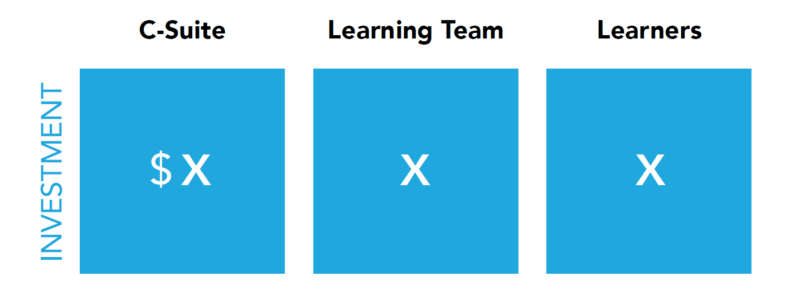
ROI, at its core, has two components: an investment and a return. But some a priori questions must be considered. Whose investment? The first answer to emerge is the investment of company management in real dollars. This is usually where the discussion stays, but it does not reflect the reality of corporate learning, training, and development programs. Certainly, the C-suite makes an investment of company resources, but that is an incomplete picture.
There are at least two additional parties who make significant investments in learning. The first is the team tasked with leading, creating, and delivering the training. These are professionals who have likely spent years earning degrees and learning to master their trade. On a daily basis, they invest their time, their energy, their knowledge and their careers to provide learning opportunities for other employees. They risk much, and they expend much. Certainly, their investment in learning needs to be considered in ROI.
Learning professionals also seek returns on their personal investment in training, which leads to another question. What are the returns? Training professionals will undoubtedly be looking to advance their careers. But in striving to create the needed learning opportunities for employees, they may be putting their careers and reputations at risk. We have spoken to many learning leaders who are making the decision to migrate their learning to a digital format. They profoundly feel the stress that goes along with this change.
The concerns of learning teams go beyond their own self-interest and careers. Most people involved in this trade are passionate about seeing others grow and develop. They are investing not only in their careers but also in the careers of those learners who will grow in knowledge and skills from the material they create. They smile when they remember an employee who started in an entry-level position and, through proper training, developed a career path that changed their life and made fuller use of their gifts and abilities. While often overlooked in the formulas and calculations, both the investment and the return of those who lead or work on learning teams must be considered to get a complete ROI picture.
The learners themselves constitute the third party who make investments and seek returns from training. They are almost always overlooked when calculating ROI. Sure, they are considered as the recipients of investment in training, and it is hoped that they create return for the company making the investment, but this is looking at them only as a function of the traditional ROI formula.
What is typically not considered is that learners also make investments in training and are looking for returns for themselves on those investments. They often have busy schedules and a long list of to-dos that require their full attention, yet they must also invest their time and mental energy into completing the training prescribed for them. Finding time for learning can put them behind schedule or actually lower their daily or weekly productivity. There is a trade-off. For them to invest in learning, it needs to be compelling, high-quality and a good use of their time. The best training addresses an immediate need at the moment of the need. It gives them a perspective they did not have before that changes how they think and act and react. It enables them to open doors and opportunities that were closed to them in the past. These are the returns they seek when they invest themselves in learning.
Corporations are made up of real people. ROI, traditionally conceived, tends to overlook this human factor. It considers training only at the transactional level. While it might contain some truth, it will never portray the whole truth about the complex ecosystem that is learning, training, and development. There are certainly transactions taking place, but they are between the C-suite and the learning team, between the learning team and the learners, and between learners and the C-suite.
Only when we consider all those who are investing and all those who seek returns will we come to a complete picture of all the costs and all the benefits of learning.
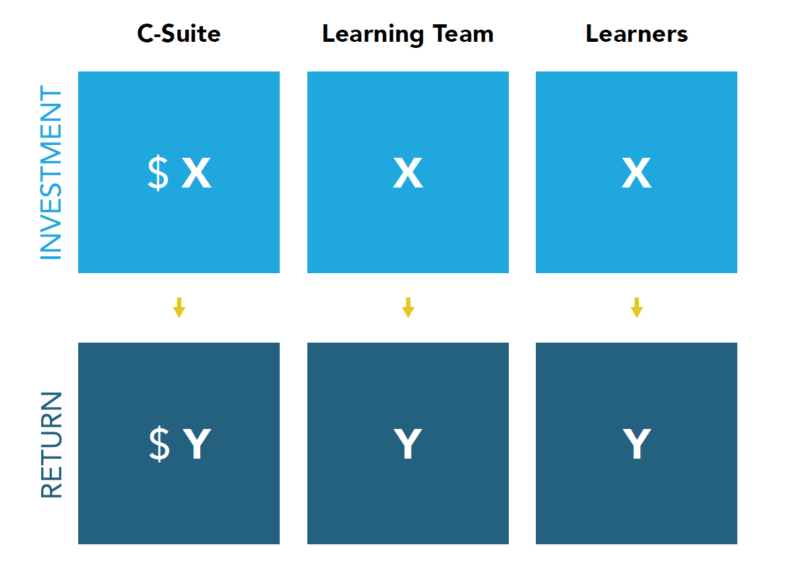
Triple Bottom Line Of Learning
What’s needed is a broadening of the camera lens to look beyond mere traditional ROI. Perhaps “appreciation” is the right term. Appreciation is learning to see things from the perspective of another. Can those in the C-suite learn to consider the investment and sought-after returns of the learning team and the learners? Can the learning team truly look with appreciation upon the learners? Can learners be taught to consider the perspective of the C-suite’s limited resources and what they hope to accomplish via training?
It is not just one group making an investment and another group seeking a return. This is the big idea behind “Triple Bottom Line of Learning” (TBLL) thinking. Three groups. Three perspectives. All have equal validity and weight. Any system that considers only one group is simply too myopic.
“Triple Bottom Line” (TBL) thinking originated in the world of accounting in an attempt to broaden the understanding of business “success.” The core idea was to move beyond looking solely at profit to determine a company’s worth because this ignores all the other potential areas of impact. The concept came from a business writer, named John Elkington, in the mid-1990s.
In Triple Bottom Line thinking, the true value of a corporation is measured in terms of its finances (the original bottom line) plus its societal and environmental impact. Profit still matters, for sure, but it is not the only thing that matters. Shareholders are a powerful consideration, but so are stakeholders, like employees, their families, the community in which the company operates, other businesses that support the company, suppliers and so on. People matter in TBL. So does the environment, which is the third bottom line.
The definition of “success” is broadened so that financial performance, thriving people and communities, and a healthy environment all play a role and must be measured. It is not that the import of financial performance is lessened; it retains its place as an essential component of a successful company. It is more that other components, people and the environment, are elevated to their proper level of importance.
What does TBL look like when applied to learning, training and development? Instead of a single metric to capture the cost of the investment and a single metric to capture the potential return, it broadens the scope of the equation to include the investments and potential returns of all involved in the learning process. Investments and their returns remain at the core of the Triple Bottom Line of Learning. The scope of those investments and their returns is expanded to consider all involved in the learning process.
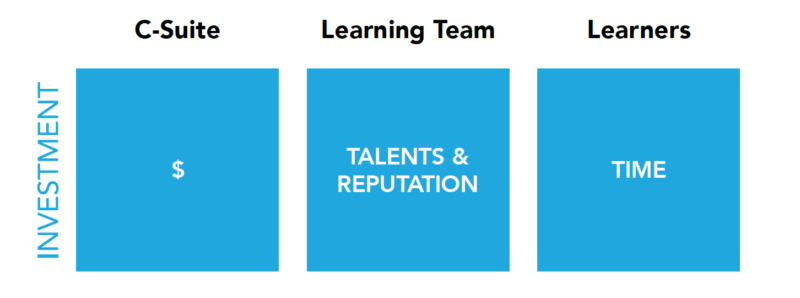
The C-suite makes an investment of financial resources. The learning team invests their talents and reputation. Learners invest their time. All types of investments must be considered. Where this broadened perspective is cultivated, healthy learning cultures are created. For an example of a company that successfully made this transition, take some time to listen to this webinar with one of the largest retailers in the United States.
All three groups also look for a return on what they’ve invested. The C-suite looks for increased team member retention, improved quality and higher levels of efficiency. The learning team looks to make the most of the resources they have been given, higher retention and the creation of a culture of learning that will empower people in their work. Learners look for training that improves their ability to do their jobs, career paths that enable them to move up, learning that is delivered when and where they need it and material that is engaging to their minds and their hearts. This type of healthy learning culture is the ultimate goal.







![Top 20 eLearning Statistics For 2019 You Need To Know [Infographic]](https://cdn.elearningindustry.com/wp-content/uploads/2019/08/top-20-elearning-statistics-2019-need-know.png)

